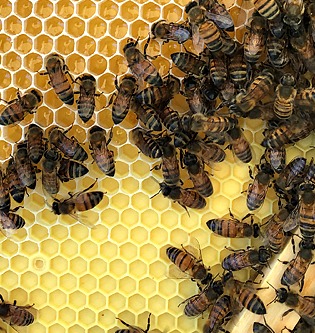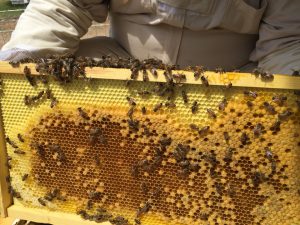The Complexity of a Hive, Part II, The Hive
By Sy Maher
There are only three types of honey bees in a hive, the drones, the workers, and the queen. They live in a social system that is both multifaceted and beautifully organized. From the moment they hatch until the time they die, one sees where the term worker-bee springs. Follow along and read about the life of the honey bee, from hatching to maturity, and the purpose of the queen.
Nurse and House Bee: On the day a fledgling bee hatches, it cleans out its own cell preparing it for the next egg. It starts work by becoming a nurse bee by feeding the brood (pupae and larvae).
Architect: These worker bees have developed beeswax glands. At this stage, their job is to cap pupae, repair damaged comb and fill cracks in the hive with propolis, a sticky substance worker bees collect from tree resin.
Cleaners: Some of the girls must keep, attend and groom their sisters (all bees are females except for the drones).
Foragers and Honey Makers: Remember that old rumor that suggested that honey came out of the wrong end of a bee. Not true. It’s the other way around. Both forager bees and honey maker bees have enzymes in their mouths. First forager bees go out and collect nectar. It is kept it in a special pouch called a honey crop. The honey crop sits right in front of its stomach. The nectar does not enter the bee’s digestive system. The honey maker sucks the nectar from the forager’s bees honey crop through their proboscis tube (mouthpart used to suck up fluid) then chews the nectar adding a special enzyme from their mouth to the mix. She then chews the substance for about of a half an hour.

About Honey Makers: These bees also fan their wings over the nectar that’s been placed into honeycombs to help it become dehydrated. When the material is sticky, they cap it with wax, and it is stored for food.
A colony of bees eats up to 200 pounds of honey per year.
More About Foragers: When bees mature, they may become foragers. These bees will collect pollen and nectar and can visit up to one hundred plants a day. Foragers will go back and forth to the hive as long as the sun is shining.

A forager collecting pollen
Certain forager bees only collect propolis the resinous substance from trees and carrying it home in their pollen baskets. Propolis is known as bee glue, and it is used to seal up unwanted holes and glue frames together.
One percent of forager bees in the hive collect water. Nurse bees use water to dilute raw honey for young larvae. Water also helps to keep the hive cool.
Undertaker: Many bees die outside the hive. If not, undertaker bees bring out their hive’s dead, and also clean up bee parts and remove other debris.
The Queen’s Attendants: Just as the courts of any palace, the queen gets her own entourage to feed and groom her.
Guard: A mature bee with a developed stinger may become a guard. A guard watches the hive’s entrances. Guards allow foragers hive sisters entrance, but keeps out bumblebees, wasps, and honey bees from other hives—and humans. If you get stung by a honey bee while standing near a hive, most likely it is a guard bee warning you. Keep away!
Drones: Drones are born out of an unfertilized egg, have no stinger, pollen baskets, or wax glands. They do not forage. They do not guard the hive. They can feed themselves after they are four days old, and feed they do, up to four times a day. Also, drones eat three times as much food as workers. This can add stress to the hives food supply. Drones are forced out of the hive when cold weather begins to cool in the fall and left to starve.
When they are about eight days old, they begin to their orientation flights.
They are there for one purpose. Fertilize queens. They are sexually mature in a week. Except for their part in the mating flight, they are not even treated as a royal sacrifice except for being allowed to chow-down when they want. If they are lucky enough to mate with the queen, they die immediately after. Sad!
The Queen: Pampered and lays eggs all day unless she gets sick, or gets old, in which case she is replaced. New queens are needed when the hive is overpopulated, and the old queen leaves in a swarm with one-third of her hive to find a new home. The queen is just a puppet for her sisters. The worker bees truly run the hive.
https://en.wikipedia.org/wiki/Honey_bee_life_cycle
https://www.popsci.com/science/article/2013-03/honeybee-society#page-



Interesting. I never knew there were so many classes of bees.